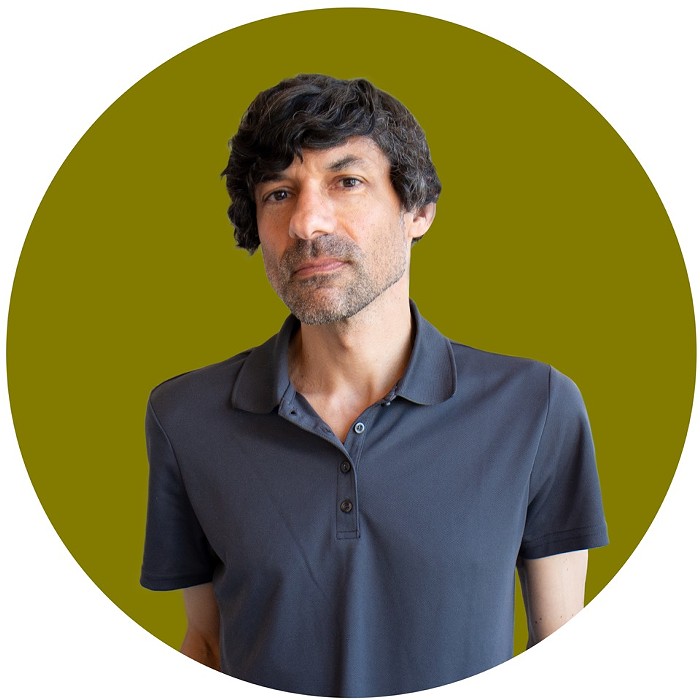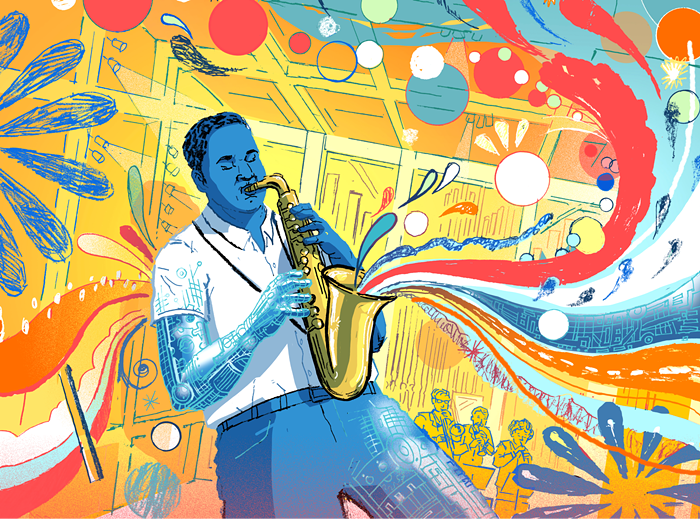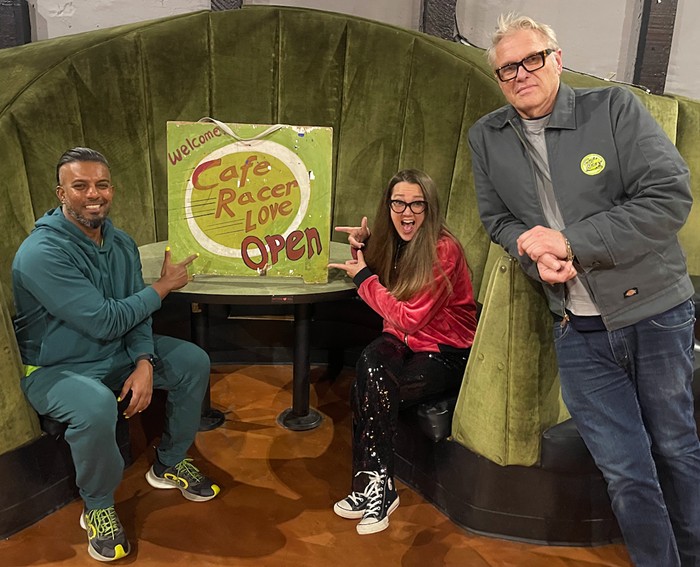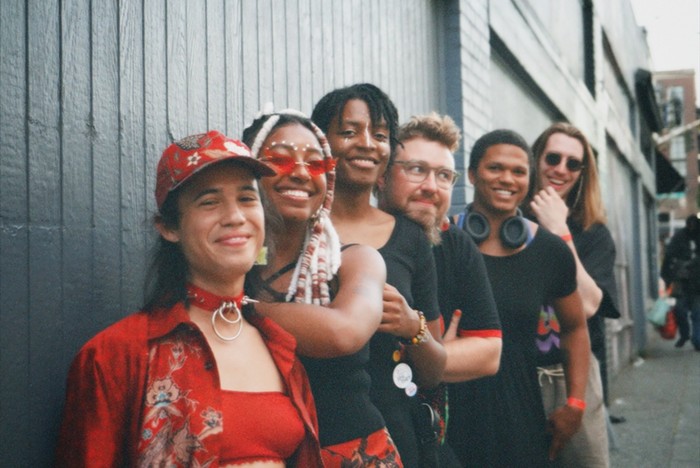
In 1989, Nirvana were releasing Bleach, Mudhoney their self-titled debut LP, Soundgarden Louder Than Love, and if you didn’t rock hard in flannel and long hair in this city, you might as well have been nowhere, on a macroscopic level (unless you were Beat Happening or the Walkabouts). That same year, part-time Seattle denizen Sue Ann Harkey issued—very quietly, albeit while in New York City—The Ancient Past and the Ancient Future Are Both Seconds Away.
To my shame, I didn’t know of its existence until this year, when I chanced upon a used copy at Daybreak Records. Its cover looked intriguing and the credits contained the name of the adventurous Seattle trumpeter Lesli Dalaba, so I sprang for it.
It’s a diverse album that dwells in its own peculiar universe, reflecting a tension between artful, vocal-based songwriting and the exploration of unusual intonations, between left-leaning political lyricism and minimalist composition.
Album-opener “Koto Tuning” is exactly that, but its serene beauty transcends by a great margin the utilitarian title. I want to start every mix I make from here on out with this track, because people urgently need the inner calm it transmits. “Open Tuning” and “From the Yoga Tapes” similarly revel in the sheer goose-bump-raising resonances of guitar strings being plucked by a masterly, instinctive musician. What could’ve come across as dry technical exercises instead ascends into the sort of sonorous sublimity maximalist-minimalist guitarist Rhys Chatham was exploring around the same time, but within a more intimate context.
Elsewhere, “The Homeless” lurches with a Beefheart-ian angularity while “It’s Not About Them, It’s About Us” strums and drangs in the vicinity of European prog-folk acts like Slapp Happy and Catherine Ribeiro + Alpes, with Harkey’s voice evoking the deep, stern timbres of Dagmar Krause and Annette Peacock. In a phone interview, Harkey—who now works as a UX designer/information architect in Seattle—says that this song was inspired by reading Wilhelm Reich’s The Mass Psychology of Fascism.
“At that time in the ’80s, there was solidarity with Poland and [the war] happening in Nicaragua, Guatemala, and El Salvador. And the Greenhouse Effect. My god, 35 years later, we’re still ignoring it, and the climate change that was happening there with the ozone hole we were battling at the time…” See, politicians should’ve been listening to this album in 1989. But no; instead they were listening to Young MC’s Stone Cold Rhymin’, Madonna’s Like a Prayer, and Tin Machine’s self-titled LP.

“Kinetic Harmony” and “There’s No Such Thing as the Masses” prefigure the stormy avant-folk drama of current indie darling Circuit Des Yeux (whom Harkey hasn’t heard). “Garret Intrigues” is a refulgent instrumental emitting deep arboreal vibes, but in a weird tuning that would impress Sonic Youth. What makes Harkey’s playing all the more remarkable is the fact that she uses a Japanese-made 12-string obtained from a pawn shop for $50 in 1979.
“There’s something about the pickups that I cannot get with any other guitar,” she says. “I had just seen Fred Frith play prepared guitar at On the Boards, and I said, ‘Wow, that’s what I want to do.’” Harkey proceeded to use all the contents of her kitchen and junk drawers and experiment on the instrument. “The main thing is that it needs an open tuning. So, on [The Ancient Past] I have four different songs in four different tunings.”
With open tunings, “no matter what you play, it’s going to sound good, because I don’t know anything about chords or anything like that. You just sort of study, spend time with the instrument, or you look up different tunings. The first track on [The Ancient Past] is tuned like a koto. But I was probably playing it with mallets or something. So how I would prepare my guitar is based on sheer physics. I’m a real purist. I don’t like any electronic effects, no pedals. It’s just me, the guitar, and the cord that goes into the amp.”
Harkey says that her playing is “all how the strings vibrate. So I’ll put a second bridge on the neck. I’ll play above the bridge and below it. I get two different tunings like that. I’ll play with mallets, with picks, with my fingers. I’ll weave things in between the strings and I’ll bounce a ball on it. I’ll drag a really long screw over the strings and get a rhythmic pattern. My first instrument was the drums in grade school. So I play very percussively. But the main thing is to make it sound not like a guitar, but to sound like a gamelan, or a koto, or a kora, or a garbage truck, or a seagull.”

Back in the '80s, Harkey’s circle of musicians—including Dalaba, Sharon Gannon (her band mate in the improv duo Audio Leter), Steve Peters (now booker of great shows at the Chapel Performance Space)—were politically engaged aficionados of the Situationists, Autonomedia, and Semiotext(e). “A lot of the stuff we were singing about in Audio Leter were these sort of revelations about philosophy. Metaphysical stuff was very interesting to us.
“[The Ancient Past] was very much a sociological, human sort of self-discovery study of what was happening politically in the world. It’s not a really popular topic with folks most of the time. A lot of times, people would prefer the instrumentals over the vocals. Sometimes it sounds a bit preachy to me, but it didn’t when I listened to it this morning, for some reason.”
Even though Harkey had played with world-jazz innovator Don Cherry and other renowned jazz and improvisational musicians during her New York stint in the ’80s, she never drew large audiences in Seattle in the ’90s. “None of my music has had much of an impact on a broad scale,” she says. “On a personal scale, my music has had a lot of influence, one on one. If anything, it would be more of a cult following. It’s all been pretty underground.
“But it’s funny how things do come full circle, and getting rediscovered after all of this time, it’s wonderful.” There’s a huge backlog of Harkey and Audio Leter material that’s long out of print. An enterprising label should reissue some or all of it; this music is too interesting and provocative to languish in obscurity.
One cool thing about Harkey is, she’s still making challenging music, even though it’s not her main focus anymore. A self-described polymath, she’s also heavily into photography, poetry, and gardening, in addition to her UX designer work. Her seven years in London earlier in the 2000s yielded a fertile and excellent experimental electronic music project with Alexander Deacon, which you can hear on her Bandcamp. Luckily, you can also catch Harkey in a rare live appearance Thursday, December 21 at Chapel Performance Space. Prepare yourself for some extraordinary prepared-guitar explorations.



















